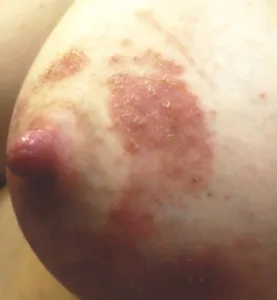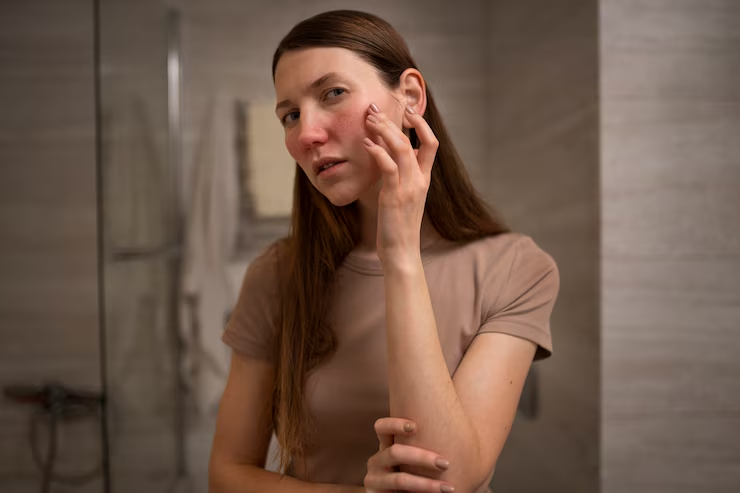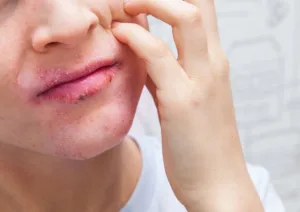Weeping eczema

Weeping eczema emerges as a complication of dermatitis, characterized by the emergence of fluid-filled blisters on the skin. This happens when there’s a lot of inflammation in the skin, causing the blood vessels in the skin to widen. This allows fluid from the blood to leak into the surrounding tissue, causing a slight swelling and the oozing of fluid onto the skin. Multiple factors can incite weeping dermatitis, including bacterial, viral, or fungal infections, often accompanied by the presence of diminutive blisters brimming with transparent fluid. It’s crucial to discern that weeping dermatitis is not an independent ailment but rather an intricacy of conventional eczema. Treatment encompasses the application of corticosteroids, antihistamines, and immunosuppressive agents, targeting the manifestation of eczema and exuding clear- to straw-colored fluid. Immediate medical attention is imperative upon the onset of symptoms to promptly manage the condition, alleviate discomfort, and effectively control any underlying infections.
Eczema on penis
Eczema affecting the penis, also referred to as genital eczema, represents a variant of atopic dermatitis impacting the genital region. This condition displays a predilection for uncircumcised males and commonly manifests with flare-ups on the glans, the head of the penis. Symptoms associated with penile dermatitis encompass dryness, itching, discoloration, inflammation, and, in severe instances, the development of open sores or ulcers. Given the similarity of symptoms to various other dermatological conditions such as jock itch, scabies, pubic lice, yeast infections, inverse psoriasis, penile psoriasis, and sexually transmitted diseases (STDs), it is essential to seek professional medical evaluation for an accurate diagnosis.
While dermatitis on the penis is not transmissible, it can be provoked by environmental triggers such as soaps, detergents, or allergens. Treatment protocols for penile eczema may involve the application of medicated creams, antihistamines, and immunosuppressive medications, alongside home remedies like cold compresses, oatmeal baths, and anti-itch formulations. Mitigating exposure to known allergens and chemical irritants remains crucial in managing and preventing exacerbations of eczema symptoms. Notably, during eczema flare-ups, engaging in sexual activity heightens the risk of bacterial colonisation, potentially exacerbating the condition, as compromised skin barrier function renders the skin more vulnerable to bacterial infiltration into the bloodstream.
Breast Eczema

Breast eczema presents as a form of dermatitis characterized by an irritating, reddened, and scaly rash affecting the nipples and areola. It’s noteworthy that this condition is non-communicable and can manifest either in individuals with eczema elsewhere on their bodies or as an isolated occurrence. Symptoms associated with breast dermatitis encompass pruritus, discomfort, parched skin, erythematous patches, thickened skin areas, scaliness, scratch-induced marks, and potential bleeding. Usually, diagnosis involves a thorough checkup by a healthcare provider, including a physical examination. They rule out other possible conditions like allergic contact dermatitis, bacterial or fungal infections, Paget’s disease of the breast, psoriasis, or other inflammatory skin problems, as well as skin cancers.
Management strategies for breast eczema entail the avoidance of triggers such as harsh cleansing agents and the regular use of moisturizing emollients. In certain cases, steroid creams may be recommended to mitigate inflammation. Seeking medical attention is imperative if symptoms persist or deteriorate, as they could signal a more serious condition like Paget’s disease of the breast, a rare form of breast cancer. Symptoms akin to those of eczema, including pruritus, nipple tenderness, thickened or scaly skin, nipple flattening, and nipple discharge, may indicate this underlying malignancy. While a definitive cure for eczema remains elusive, appropriate treatments can effectively manage symptoms and reduce the likelihood of flare-ups.
Adopting measures to avoid specific triggers, such as stressors, pollen, fungi, and pet allergens, along with adhering to prescribed emollients and steroid creams, plays a pivotal role in symptom management. In essence, breast eczema, though commonplace, warrants prompt medical attention if symptoms persist or worsen, underscoring the importance of professional evaluation for potential underlying complications.
Papular Eczema

Papular eczema, also known as papular dermatitis or subacute prurigo, is a type of eczema where small itchy bumps (papules) appear on different parts of the body, like the arms, legs, neck, chest, and buttocks. These papules, resembling pimples but devoid of pus, manifest as a distinctive manifestation of the condition rather than constituting a distinct entity from atopic dermatitis. Papular eczema may persist chronically or manifest sporadic flare-ups amidst periods of remission, posing diagnostic challenges due to its likeness to other dermatological ailments.
The precise etiology of papular eczema remains elusive, though it correlates with skin inflammation triggered by unidentified stimuli. Factors commonly associated with eczema, including seasonal allergies, asthma, and specific medications, are implicated in exacerbating papular eczema. Moreover, individuals with a history of eczema, asthma, or hay fever exhibit a heightened susceptibility to this condition, indicating a notable genetic predisposition.
Managing papular eczema typically entails addressing itchiness and inflammation. Non-steroidal therapies, such as immunosuppressants, function by dampening various immune responses to alleviate skin inflammation. Additionally, phototherapy, utilizing ultraviolet light to mitigate inflammation, has been explored as a potential intervention for papular eczema.
Preventing flare-ups of eczema necessitates the identification and avoidance of triggers, coupled with maintaining optimal skin hydration and utilizing gentle, fragrance-free skincare products. Particularly for papular eczema, abstaining from scratching the pruritic papules is imperative to avert potential infections resulting from repetitive scratching.
Simply put, papular eczema is a type of eczema where itchy bumps appear on the skin due to inflammation caused by unknown factors. Diagnosis can be challenging due to its resemblance to other dermatological conditions. Treatment revolves around managing symptoms and preventing flare-ups by identifying and mitigating triggers.



